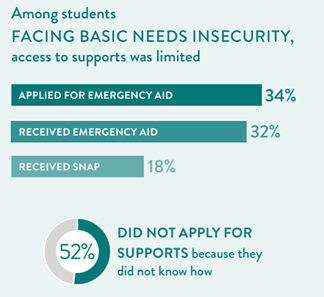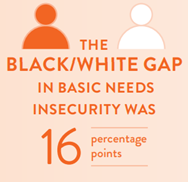 At the end of March, the Hope Center for College, Community, and Justice released its #RealCollege 2021 report, which sheds more light on the situation over 200,000 college students faced during the fall 2020 semester. The report, which comes out several times a year, surveyed students from 130 two-year colleges and 72 four-year colleges and universities. Some of the most significant findings emphasize research FCAN has previously covered, but we find it essential to highlight for higher education advocates.
At the end of March, the Hope Center for College, Community, and Justice released its #RealCollege 2021 report, which sheds more light on the situation over 200,000 college students faced during the fall 2020 semester. The report, which comes out several times a year, surveyed students from 130 two-year colleges and 72 four-year colleges and universities. Some of the most significant findings emphasize research FCAN has previously covered, but we find it essential to highlight for higher education advocates.
Most students experienced some form of basic needs insecurity
Nearly 3 in 5 respondents experienced basic needs insecurity in the fall of 2020. Basic needs insecurity (BNI) includes food insecurity, housing insecurity, and homelessness. Nearly half of all respondents were affected by housing insecurity, most commonly through a struggle to pay rent and/or utility bills. 14% of students experienced homelessness.
The pandemic has had disparate impacts on some college students. For example, 75% of indigenous students, 70% of Black students, and 70% of American Indian or Alaska native students experienced BNI, compared to about half of all White students. Other groups also experienced disproportionate challenges: 65% of LGBTQ students, 67% of Pell Grant recipients, and 67% of students attending HBCUs experienced some form of BNI. Later this year, the Hope Center will publish further information about basic needs at HBCUs.
Additionally, more than 1 in 3 students said they lost a job because of the pandemic, while 1 in 4 reported fewer hours or lost wages. Students of color experienced higher job losses/reduction in pay.
Utilizing emergency aid
 Although many students reported needing extra support, only one in three applied for emergency aid. Over half of respondents said they did not apply for support because they did not know how. For students who received aid, the top uses of aid were to stay enrolled, afford educational materials, reduce stress, have more food to eat, and pay for transit and housing. Highlighting the need for clear language and outreach at campuses, the most common reason students did not use campus support was that they didn’t think they were eligible and assumed others needed support more than them.
Although many students reported needing extra support, only one in three applied for emergency aid. Over half of respondents said they did not apply for support because they did not know how. For students who received aid, the top uses of aid were to stay enrolled, afford educational materials, reduce stress, have more food to eat, and pay for transit and housing. Highlighting the need for clear language and outreach at campuses, the most common reason students did not use campus support was that they didn’t think they were eligible and assumed others needed support more than them.
Further struggles
This #RealCollege survey offered new information on how students experienced the difficulties of the coronavirus pandemic. While only about 7% of students got sick themselves, 41% had a close friend or family member get sick with COVID-19. About 1 in 8 students lost a loved one to COVID-19. Like we know COVID disproportionately affected some communities more than others, both Black and Latinx students were more than two times as likely than White students to lose a loved one to COVID-19.
Considering the increased basic needs insecurity and extra trauma students faced from the pandemic, it makes sense that over 1 in 3 students exhibited moderate anxiety. This aligns with a number of studies that show the pandemic has taken a toll on students’ mental health in the United States. The Hope Center will release a future report on the pandemic’s impact on students’ mental health.
About one-sixth of the respondents, more than 32,000 students, are also parents. These students faced unique struggles during the pandemic as learning moved online for most K-12 schools. Out of students who are also parents, more than 75% reported they had to help children in their home with school while attending their own classes. More than a quarter of students who are also parents missed 6 or more days of work or class due to childcare arrangements.
Importantly, even though the 200,000 students who responded to this iteration of the #RealCollege survey represent the highest ever for the HOPE Center, it is possible the students who did not respond are the most in need. Students without a home or stable internet are less likely to have even responded to this survey, potentially producing conservative estimates.
Implications
 The pandemic has brought hardship to people across this world. And yet, the results of this report show the pandemic exacerbated inequalities for some groups more than others, and thus, a one-size-fits-all approach will not work to support college students. For example, students who are parents have struggled to continue their own education while navigating school and daycare closures, which has dramatically affected single mothers in particular. The disparities were also highlighted in use of campus aid and support: although 68% of Black males experience BNI, only 31% of those with need utilized campus supports; only 26% of Latinx females used supports, although 60% of Latinx females were in need.
The pandemic has brought hardship to people across this world. And yet, the results of this report show the pandemic exacerbated inequalities for some groups more than others, and thus, a one-size-fits-all approach will not work to support college students. For example, students who are parents have struggled to continue their own education while navigating school and daycare closures, which has dramatically affected single mothers in particular. The disparities were also highlighted in use of campus aid and support: although 68% of Black males experience BNI, only 31% of those with need utilized campus supports; only 26% of Latinx females used supports, although 60% of Latinx females were in need.
We already know Florida has significant gaps in degree attainment for Black, Latinx, and Native American Floridians. Supporting college students means implementing policies that recognize the varied non-academic issues students face when pursuing education after high school, including food insecurity, a lack of information about campus supports, and childcare access. The #RealCollege survey offers policy recommendations for state, federal, collegiate, and educational leaders, and many of them are relevant to the college access work FCAN supports in Florida.
For more detailed recommendations, see the full report at the Hope Center’s #RealCollege 2021 page.
RELATED ARTICLES:
Nearly 3 in 5 college students struggle with food, housing insecurity due to COVID-19
With more expected emergency aid dollars coming, the Hope Center offers recommendations for institutions
Visit FCAN’s COVID-19 Resources & Information section


